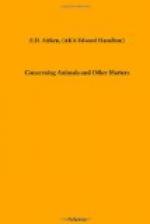If we try to commence—as scientific method requires—with a definition, we stumble on a key, at the very threshold, which opens the door. For there is no definition of a tail; it is not, in its nature, anything at all. When an animal’s fore-legs are fitted on to its backbone at the proper distance from the hind-legs, if any of the backbone remains over, we call it a tail. But it has no purpose; it is a mere surplus, which a tailor (the pun is unavoidable) would have trimmed off. And, lo! in this very negativeness lies the whole secret of the multifarious positiveness of tails. For the absence of special purpose is the chance of general usefulness. The ear must fulfil its purpose or fail entirely, for it can do nothing else. Eyes, nose and mouth, hands and feet, all have their duties; the tail is the unemployed. And if we allow that life has had any hand in the shaping of its own destiny, then the ingenuity of the devices for turning the useless member to account affords one of the most exhilarating subjects of contemplation in the whole panorama of Nature. The fishes fitted it up at once as a twin-propeller, with results so satisfactory that the whale and the porpoise, coming long after, adopted the invention. And be it noted that these last and their kin are now the only ocean-going mammals in the world. The whole tribe of paddle-steamers, such as seals and walruses and dugongs, are only coasters.
Among those beasts that would live on the dry land, the primitive kangaroo could think of nothing better to do with his tail than to make a stool of it. It was a simple thought, but a happy one. Sitting up like a gentleman, he has his hands free to scratch his ribs or twitch his moustache. And when he goes he needs not to put them to the ground, for his great tail so nearly equals the weight of his body that one pair of legs keeps the balance even. And so the kangaroo, almost the lowest of beasts, comes closer to man in his postures than any other. The squirrel also sits up and uses his forepaws for hands, but the squirrel is a sybarite who lies abed in cold weather, and it is every way characteristic of him that he has sent his tail to the furrier and had it done up into a boa, or comforter, at once warm and becoming. See, too, how daintily he lifts it over his back to keep it clean. The rat is a near relation of the squirrel zoologically, but personally he is a gutter-snipe, and you may know that by one look at the tail which he drags after him like a dirty rope. Others of the same family, cleaner, though not more ingenious, like the guinea-pig, have simply dispensed with the encumbrance; but the rabbit has kept enough to make a white cockade, which it hoists when bolting from danger. This is for the guidance of the youngsters. Nearly every kind of deer and antelope carries the same signal, with which, when fleeing through dusky woods, the leader shows the way to the herd and the doe to her fawn.




